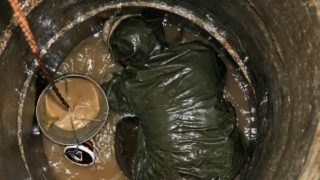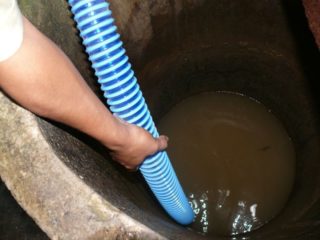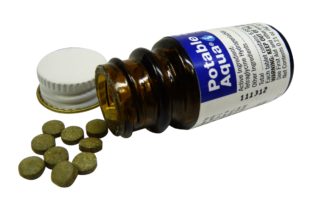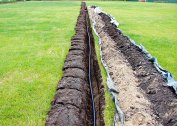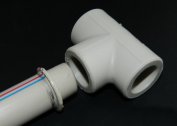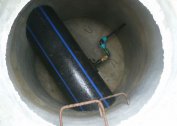If the owner of the plot has doubts about the purity of the water in the source, or an examination has confirmed the unsuitability of its use in food, it is necessary to disinfect the well for drinking water. This liquid is dangerous to eat, it may contain pathogens. Well cleaning and maintenance should be carried out efficiently and regularly.
In what situations may a well disinfect water in a well?
Disinfection of a well involves several stages: cleaning the source mine and disinfecting the contents. All sources without exception, regardless of the frequency of use and their intended use, must be cleaned.
The main reasons for which you need to regularly carry out disinfection:
- the presence in the well of debris, dust and other third-party objects;
- flooding due to spring flood;
- formation of mucus, fungal and salt deposits, mold on the walls of the mine;
- ingress into the source of melt, rain or sewage;
- active use of the well, as a result of which there is a subsidence of the aquifer of the soil;
- penetration into the soil of sewage, processed products of agricultural and industrial enterprises;
- getting into the well of bodies of dead animals and birds.
Water with an unpleasant odor is unsuitable for consumption in food, and sometimes for domestic purposes. Therefore, it is recommended to clean and disinfect the source regularly.
Disinfection preparation
The quality and speed of the work will largely depend on the correctness of the preparatory measures.
First of all, you need to completely pump out the fluid from the well using a pump. If there is little water, a surface pumping station is sufficient. If the fluid level is impressive, more powerful submersible models will be required. Before turning on the equipment, you need to remove floating debris from the mirror, this can be done using a net with a long handle.
After emptying, the sources sink into the well and inspect the bottom and walls for cracks and other damage. If cracks are found, they are treated with a special waterproofing solution. Mucus, fungus, sludge, algae and debris are also removed from the walls.
For the preparatory work, you need hard brushes and spatulas. At the bottom of the well, sediment is removed and, if possible, the bottom filling is replaced with a new one. To do this, use sand, gravel or fine gravel.
If plaque forms on concrete rings, it is also removed. For this, various industrial and folk remedies are used, the combination of components of which depends on the nature of the origin of the deposits. For example, salt deposits are removed with drugs that include hydrochloric acid, or with vinegar diluted with vinegar essence.
Corrosion foci are best removed with a grinder or jackhammer, the surface is also necessarily treated with a special anti-corrosion compound. If mold foci are actively formed, the entire surface is treated with copper sulfate.
Effective Disinfection Methods
An industrial or folk remedy for treating water in a well should have the following characteristics:
- Residues of industrial composition are easily removed.
- Effectively destroy pathogenic microflora and pathogens, have pronounced antibacterial properties.
- Be safe for human health.
- Do not have a damaging effect on the walls of the shaft.
After using industrial compounds for pumping water, it is recommended to use an old pump, which may fail and it will not be a pity to part with it.
Well disinfection pills
The industrial market offers a convenient chlorine-based tablet cleaner.
The average consumption per well is 4 tablets, previously dissolved in a bucket of clean water. The exact dosage can be calculated using the attached instructions for use.
The disinfection process is carried out in two stages:
- The preparatory phase includes pumping water, removing contaminants from the walls and bottom. After this, the walls are irrigated with the resulting solution. The active composition is left on the surface of the walls for half an hour, and then the residues are washed off with clean water.
- Water disinfection. Pills are added to the well filled with water. Leave for 6-12 hours, after - pump out water until the smell of bleach disappears.
The main disadvantages of the drug include only high cost.
Manganese solution
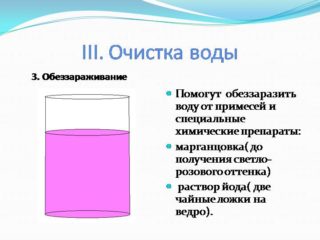 The potassium permanganate solution is a natural antiseptic for a well with drinking water. The method refers to the gentle. In terms of effectiveness, it is significantly inferior to the method using chlorine.
The potassium permanganate solution is a natural antiseptic for a well with drinking water. The method refers to the gentle. In terms of effectiveness, it is significantly inferior to the method using chlorine.
To prepare a disinfecting solution, you will need 10 liters of water and 1 tablespoon. Manganese The components are mixed until a homogeneous state, the water turns pink. It is poured into the well and the composition is left for half an hour or an hour, then several times you need to pump out water.
After cleaning, dry the walls of the well with a brush, and put a mesh of manganese on the bottom to provide a disinfecting and antibacterial effect. As an alternative, you can use silicon chips, it also has a pronounced antibacterial effect.
Iodine
It is better to give preference to more thorough cleaning and disinfection of water, but if this is not possible, you can resort to this method. It is easy to implement. You need to prepare a solution - 1 drop of water 3 drops of iodine - and pour it into the mine. Thanks to this simple action, with regular execution it will be possible to significantly improve the chemical composition of well water and delay the purification of the source.
Preventative measures
Preventive disinfection of the well should be carried out at least once a year.
In order to prevent water pollution in the future, the following preventive measures must be taken:
- Arrangement of a clay castle. To do this, you need to dig a trench near the well with a depth of not more than 2 m and a width of 0.5 m, tightly hammer it with clay, making a small angle of inclination. This method will prevent moisture and contaminants from entering the soil, which can penetrate the source itself through the seams between the rings.
- Production of high-quality bottom filter. It is made of a layer with a thickness of at least 10 cm of silicon gravel and 20 cm of a mineral of volcanic origin - zeolite. Before filling, the raw materials must be washed with clean running water.
- Making a roof over a well or building a house. They will prevent dirt and dust from entering the mine.
Preventive measures will help reduce the frequency of harvesting and the rate of water pollution in the source. The bottom filter needs regular replacement.
